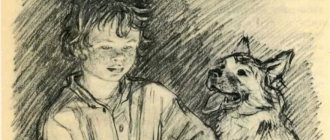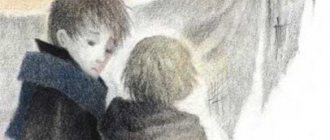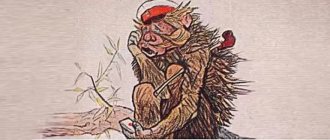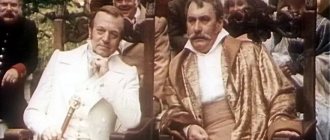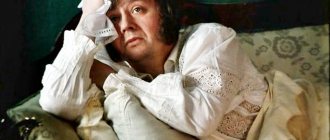The work of I. S. Turgenev “Bezhin Meadow” tells about children of the distant nineteenth century. Against the backdrop of a vivid image of the surrounding nature, the author talks about the life of peasant boys, correlating the features of their appearance with their character traits. A detailed description of each character allows you to accurately depict portraits from the story “Bezhin Meadow” in an essay for grade 6, which is mandatory in the literature program.
Images of boys in the work
The story is told from the perspective of a lost hunter. Wandering through the forest, towards nightfall he comes out to a meadow where local boys are grazing a herd. In the dark around the fire, they share scary stories and legends with each other, argue about evil spirits. Listening to stories, the traveler carefully observes each storyteller and very subtly notices the features of the appearance and characters of the little shepherds .
The children work from a very young age and share all daily concerns with adults.
Understanding more deeply the entire conversation of the boys, one can understand that the hardships of peasant life are reflected through their lips. Nevertheless, childish spontaneity still slips into the speech of children, in their gestures and facial expressions.
Summary of the essay “Bezhin Meadow”
The narrative of “Bezhin Meadow” begins with the narrator going out hunting and admiring how the morning comes. Already late at night, returning home, he got lost and goes out to Bezhin meadow, where a huge fire is burning, and several peasant children are sitting near it in the night. Having explained who he is, the writer also sits down by the fire.
After this, Ivan Turgenev gives a wonderful description of the night, which he really likes for its mystery and mystery. He also describes the boys he saw near the fire. There were five of them in total. The boys are hungry, so they boil potatoes in a pot. After a while, the author goes to bed and soon pretends to be asleep. This gives the boys an opportunity to continue the conversation. The topic of conversation turns out to be very interesting - evil spirits and everything that can be connected with it. For example, Ilyusha’s story about the brownie who lives in a paper factory.
The next story is from Kostya, who tells an incident that happened to a local sweater, and which made him such a gloomy type. It turned out that Gavrila met a mermaid whom he fell in love with. And again Ilya’s story about the drowned man sounds. At this moment, the dogs suddenly burst out of their seats and rush somewhere, barking. But soon everything calms down again, and the stories continue again. I tell the boys about everything: about werewolves, about wolves, and then the topic of their conversation becomes the dead. It is interesting that children are also interested in natural phenomena. They talk about a solar eclipse and try to explain it from a divine point of view.
Later, a dispute arises between the boys about what kind of evil spirits are found in their area. They remember not only the merman, but also those people who drowned. They even imagined the voice of Vasya, a boy who had recently drowned. This is followed by a description of the night, and then the sky and forest as the sun begins to rise. Soon the narrator leaves the guys. And later he learns that Pavlusha will die by falling from a horse.
Portrait characteristics of heroes
The author subtly conveys the bright individuality of the village children. An accurate verbal description allows you to figuratively imagine what is happening around the fire:
- The central character is twelve-year-old Pavlusha. Outwardly, the boy looks unprepossessing and squat, but despite this, he creates a pleasant impression. He is businesslike and calm. There is no devilry in his story, since Pavlusha is the least likely to believe village stories. He gives a scientific explanation for the frightening sounds at night. The boy is very brave - without hesitating for a minute, he rushes towards danger. Pavel impresses the narrator, who notices that the boy has intelligence and inner strength.
- Fourteen-year-old Fedor is a slender boy with pleasant facial features. In communication he puts himself above others and says little. During the conversation, the boy did not tell a single story. Fedya is well dressed and gives the impression of a child from a rich family. Most likely, he ended up in the field at night for fun.
- Ilyusha is 12. From his stories we can conclude that he is a patient and hardworking boy. The author characterizes the appearance as neat. The sound of the voice - hoarse and weak - matches the facial expression. As if worried about something, Ilyusha constantly adjusts his hat, purses his lips and has an expression of painful concern. The boy is well acquainted with popular beliefs and loves scary stories, of which he is the author in the story. It is he who becomes the main storyteller around the fire.
- Kostya is a ten-year-old boy of small stature, with a face dotted with freckles and large black eyes expressing slight sadness. The boy is still quite small and very impressionable, often flinches from sharp sounds. Kostya evokes the reader's sympathy. He perceives the stories of other interlocutors as children's fairy tales. The story about the mermaid is presented in the same form.
- The youngest Vanya is 7 years old. The author says little about him. Due to his age, the boy is a coward. The traveler does not even immediately notice the youngest shepherd. Almost all the time he slept under the matting. Only at some point the boy “exposed his fresh face... and slowly raised his big, quiet eyes upward.” In Vanya’s description, the hunter notes his curly hair and burr.
As the author describes the features of the appearance, speech and actions of each character in the story “Bezhin Meadow”, the portraits of the boys become quite lively and convincing.
“Bezhin Meadow”: mysticism in Turgenev’s works, hostile nature and fateful fate
What's the point?
“Bezhin Meadow” is a simple work at first glance, however, when analyzing it, it is necessary to eliminate inaccuracies that students sometimes make in essays and oral responses.
Who is the main character?
Formally, “Bezhin Meadow” is a story about children. In fact, its main character is the Russian night nature, mysterious and strong. And the children themselves, herding horses in the night and whiling away the night by the fire with scary stories, are children of nature, to whom she is for the time being favorable. But to the narrator, the element of night appears in all its horror and splendor. A night landscape full of mystical danger, power and indifference to a lost person. This is a classic example of the image of nature in Turgenev’s work: an unbridled force living its own life, showing the random traveler that he is a stranger to it and ready to devour him at any moment.
Human and nature.
Sometimes in student essays, less often in educational literature, you can find statements that from the changes taking place in nature, “one can see how the narrator’s mood changes.” This is not an entirely accurate statement: in Turgenev, the narrator’s mood always changes following nature; this is not a reflection of a person’s mood, but, on the contrary, a person’s reaction to changes in the external environment. In this case, the narrator is influenced by the looming terrible immense darkness, night sounds and night silence, unexpected landscapes, deceptive hills and winding paths. It can be noted that nature for Turgenev personifies the path to an unfamiliar, wild, different world, in which a person is powerless and weak. It is known that Turgenev was an atheist by conviction, but at the same time he was a mystic and had an amazing ability to subtly sense fears and worries - both in nature and in the human soul.
Literature. 8th grade. Workbook. No. 1.
The questions and tasks presented in the notebook correspond to the contents of the textbook included in the “Algorithm for Success” system (authors B.A. Lanin, L.Yu. Ustinova, V.M. Shamchikova) taking into account the structure of state certifications in the 9th and 11th grades (OGE and Unified State Examination). The educational material is accompanied by colorful illustrations, which make it possible to intensify work on the development of students' speech. Corresponds to the Federal State Educational Standard of General Education (2010).
Buy
What to take for processing?
Day and night.
Turgenev is truly an unsurpassed master of verbal landscapes; even Vladimir Nabokov, a very demanding reader who considered Turgenev “an unremarkable fiction writer,” paid tribute to him as a singer of nature. Review two passages with your students: a description of the morning with which the story begins, and a description of the evening and night when the narrator admits to himself that he is lost. Pay attention to the artistic means the author uses. You can create two fields of epithets and metaphors: daytime and nighttime. The most expressive passages describing nature can be learned by heart.
Portraits of boys.
“Bezhin Meadow” gives us a classic example of a literary portrait. In UMK T.F. Kurdyumova’s textbook for 6th grade teaches the story in exactly this vein; in the electronic form of the textbook, the study begins with a detailed multimedia presentation dedicated to the literary portrait. Then a virtual test is given, where students are asked to recognize the character from a verbal portrait. Only after this do students begin to analyze the story “Bezhin Meadow”, ready to notice all the details and draw conclusions about Turgenev’s creative skill.
The writer describes all the children in detail, and then allows their images to be fully revealed - through their manner of speaking, reactions, and behavior. Discuss the character of each character in class, and then try reading the dialogue by role, trying to highlight the features of their images. Vanechka will be the most frightened of all, Fedya will take the initiative, try not to show that he is worried, Pavel may even treat some of his comrades’ fears condescendingly. Students will be able to prove their vision of the character through their reading style.
The theme of fate.
The story has an interesting plot line: at some point the children need to go get water. This means moving away from the saving warm fire, stepping into the dark abyss of hostile nature, approaching the water (and in the water there is the evil spirit that we just talked about!)... Pavel, the most strong-willed and courageous of all the children, decides to bring water. He returns, proud of himself and the fact that higher powers did not touch him. Then, in the finale, we learn that a year after the evening described, Pavel fell from his horse and died. This non-random detail is worth special discussion: strong-willed characters are present in Turgenev’s novels, they are attractive and interesting, but in the end fate certainly finds such people and punishes them for being brave and ready to act.
What to discuss in class?
For the young heroes of the story “Bezhin Meadow”, everyday mysticism - folk beliefs, brownies, mermaids - is an integral part of everyday life, a way to explain everything inexplicable. But why do children of the 21st century, who have access to any scientific information, still like “horror” films so much - “Creepy Children’s Folklore” collected and processed by Eduard Uspensky, numerous thrillers by Stephen King, “animatronics”, etc.? What can you find for yourself in mystical literature - an opportunity to “tickle your nerves”, attract the attention of peers, or something more? Maybe these days we also tend to look for explanations for incomprehensible phenomena not in the field of science, but in everyday magic?
Literature. 5 grades Workbook in 2 parts. Part 1. VERTICAL
The workbook is part of the teaching materials on literature edited by T. F. Kurdyumova and corresponds to the Federal State Educational Standard for basic general education. The notebook can also be used with a textbook that complies with the Federal component of the state educational standard. In addition to the notebook, the educational complex includes an electronic supplement to the textbook, a methodological manual and a work program. Free access to the electronic application and work program can be obtained on the website www.drofa.ru. Special signs mark tasks aimed at developing meta-subject skills (planning activities, identifying various features, comparing, classifying, establishing cause-and-effect relationships, transforming information, etc.) and personal qualities of students.
Buy
What to leave for the future?
Turgenev is an unusually realistic writer. He doesn’t invent anything, but only observes and describes real people, nature, and events. The scary stories from the story “Bezhin Meadow” were also not invented by the writer: these are real everyday legends that wandered around his family estate, Spassky-Lutovinov. Turgenev's childhood was filled with these eerie stories - most likely, this played a role in his further attraction to mysticism. This is what Yuri Lebedev writes about it:
“...All the legends about the founder of the Spasskaya estate were invariably painted in some kind of eerie tones. Ivan Ivanovich was buried in the family crypt under the chapel, which he himself built at the entrance to the estate, in the corner of the old cemetery. The peasants associated a terrible belief with this chapel and the Varnavitsky ravine located not far from it. These two places were considered unclean by the people: the deceased master lay restless in the stone crypt, his conscience tormented him, the grave weighed on him. They said that at night he leaves the chapel and wanders through the thickets of the remote Varnavitsky ravine and along the dam of the pond in search of gap-grass. This legend has been passed down from generation to generation, and it is no coincidence that it sounds in the mouths of the peasant children from “Bezhin Meadow”.
Turgenev himself avoided the Turgenev family crypt at the Spassky cemetery in every possible way and never wanted to be buried there: since childhood, these places aroused fear in him. Another “unclean place” in Spassky-Lutovinovo is an abandoned estate on Ivanovsky Field. All that was left of the house, garden and park were ditches, a dry pond and three tall spruce trees growing close to each other. “In 1847, during a storm, one spruce fell onto the shaft of a ditch so that its top remained above the ground and served as a funny swing for peasant children, until one day the spruce rolled down and overwhelmed a boy and a girl with its top,” says Yuri Lebedev.
Echoes of this story were subsequently heard in the novel “Rudin”; Turgenev used the ominous landscape of Ivanovsky as one of the settings for the actions of the novel.
“Avdyukhin pond, near which Natalya made a date with Rudin, has long ceased to be a pond... There was an estate right there. She disappeared a long time ago. Two huge pine trees reminded of her; the wind was always noisy and humming gloomily in their tall, skinny greenery... Mysterious rumors circulated among the people about a terrible crime that had allegedly been committed at their root; they also said that not one of them would fall without causing death to someone; that there used to be a third pine tree, which fell during a storm and crushed the girl.”
So Turgenev was a mystic; he was attracted to stories related to inexplicable forces, be it fate, fate or everyday beliefs. Turgenev wrote his most mystical works at the end of his life; their creation is usually associated with the fact that in the last months of his life Turgenev suffered from spinal cord cancer, could not live without morphine and often complained of nightmares. The latest works of Turgenev are not included in the school curriculum; they can be left “for growth” by the most interested students.
Literature. 7th grade. Workbook
The workbook is included in the teaching materials on literature for grade 7 (authors G.V. Moskvin, N.N. Puryaeva, E.L. Erokhina).
Designed for independent work by students, but can also be used in class. Buy
Characters through the eyes of artists
The visual characteristics of the guys’ appearance prompted many painters to paint the plot of the work. Nature conveys the feeling of a dark night around a fire. Thanks to the completeness of perception, the artists' pencil falls on the paper with a natural and beautiful pattern.
Images of peasant children and the theme of “Night” often run through the work of painters. Village children are attracted by their spontaneity and closeness to nature. Inspired by Turgenev’s story “Bezhin Meadow,” many famous artists created drawings:
- Pakhomov Alexey Fedorovich.
- Bykovsky Vladimir Afanasyevich.
- Lebedev Klavdiy Vasilievich.
- Belyukin Anatoly Ivanovich.
- Ermolov Vladimir Alekseevich.
- Davydova Anna Arkadyevna.
- Kondratyev Alexander Vasilievich.
- Konashevich Vladimir Mikhailovich.
- Kupriyanov Sergey Alekseevich.
- Rachkov Nikolay Efimovich.
The artists' canvases depict one scene - boys guarding a herd, and a random traveler at a night fire - but each author brings new colors to it, his own unique nuances and motives.
The drawings for the story “Bezhin Meadow” are mysterious, as is the state of the village boys who tell terrible superstitions. The bright, surprised faces of the children depicted in the paintings do not leave anyone indifferent and are remembered for a long time.
Series of illustrations by A. F. Pakhomov
The best and rightfully innovative paintings for the story “Bezhin Meadow” can be considered the works of A.F. Pakhomov, in which he portrayed the main characters - Pavlusha, Ilyusha, Fedya, Vanya, Kostya, and the lost hunter . The delights of a summer night around a fire are familiar to Pakhomov firsthand. As a child, he had been in the night room more than once. He tried to convey childhood memories close to his heart, the images of his boy friends with their stories about various devilry, and the feeling of friendship in his works.
The artist compared the external description of the characters with their actions and conversations, thereby reviving the boys’ features in his paintings . It seems to the reader that this is exactly how he imagines each hero.
The famous Soviet artist managed to deeply and psychologically convey the images of simple-minded village children and the atmosphere of the entire work in a series of pictures.
The description of nature in the story contributes to the most complete artistic perception of A. F. Pakhomov’s paintings. The work is filled with landscape sketches that complement the experiences and appearances of the characters and determine the internal tension of what is happening.
“Bezhin Meadow” is the embodiment of the author’s perception of the connection between nature and man in the paintings of various artists.
Heroes of Turgenev's story “Bezhin Meadow”
In this unusual story, the author decided to use speculation about brownies, goblins and even mermaids, who have long become poetic heroes of folklore. He was able to use the stories that he heard from the mouths of the children without inventing anything, but only correctly put them on paper, preserving the peasant flavor. The author was amazed by the courage and talent of children who live in poor peasant families. Therefore, it was children of different ages that the author decided to show in his story.
He describes the boys in detail. There are five of them in the work:
♦ Fedya. ♦ Pavlusha. ♦ Ilyusha. ♦ Kostya. ♦ Vanya.
First of all, the author begins the reader’s acquaintance with his characters by describing their appearance in detail, and telling everything down to the smallest detail. For example, about Fedya, the author writes that he looked about fourteen years old, but he was very thin and that made him seem slender. I was also attracted by the child’s face, which was beautiful. And this beauty was created due to his subtle and small facial features. His blond hair was also beautiful, which nature created as if it were real curls. There was always some strange smile on his face, either cheerful or absent-minded. And all this was in perfect harmony with her light eyes.
But if Fedya was from a wealthy family, and he spent time with peasant children for the sake of interest and entertainment, then Pavlusha was the complete opposite. According to the description, his black hair was always tousled. Wide cheekbones and gray eyes stood out on the face. The boy’s face itself was pale and pockmarked, and this made his mouth seem large. But then the author, trying to justify his such a description, writes about the character of the child, who looked straight, thought was visible in his eyes and all his conversations showed that he was a smart boy. But of particular interest was his voice, in which one could hear the strength.
The third peasant boy is Ilyusha. According to the description, this was a completely different type. So, the face did not represent anything interesting: the nose had a hump, the oval of the face was elongated. He was a little blind, so he squinted all the time, as if from fire. The boy had a kind of caring expression on his face. It seemed that this concern had already reached the point of some kind of illness or stupidity. The child's eyebrows were always knitted, and he pressed his lips tightly and, looking at them, it seemed that they never moved.
Kostya, the fourth hero of Turgenev's story, was unlike the previous boys. He looked about ten years old, no more. His whole face was covered in freckles, it was small and very thin. The face was slightly pointed at the bottom, like a squirrel's. The boy's lips were so thin that they could hardly be distinguished on his face. But what gave him a special and strange impression were his eyes, which on his thin face seemed not only large, but huge. Kostya’s eyes were large and shiny, they seemed to want to say something that could not be expressed in words.
The last hero, the fifth boy, Vanya, was just a baby, about seven years old. The author does not give a detailed description of this child, since when they met he was lying under the matting as if he was sleeping. So, quietly and calmly, he listened to the children’s stories, and only sometimes, in the most interesting places, he stuck his head out, and then one could see that his hair was brown and curly. All the heroes of Turgenev’s essay “Bezhin Meadow” are covered in sadness, sadness and sympathy.
